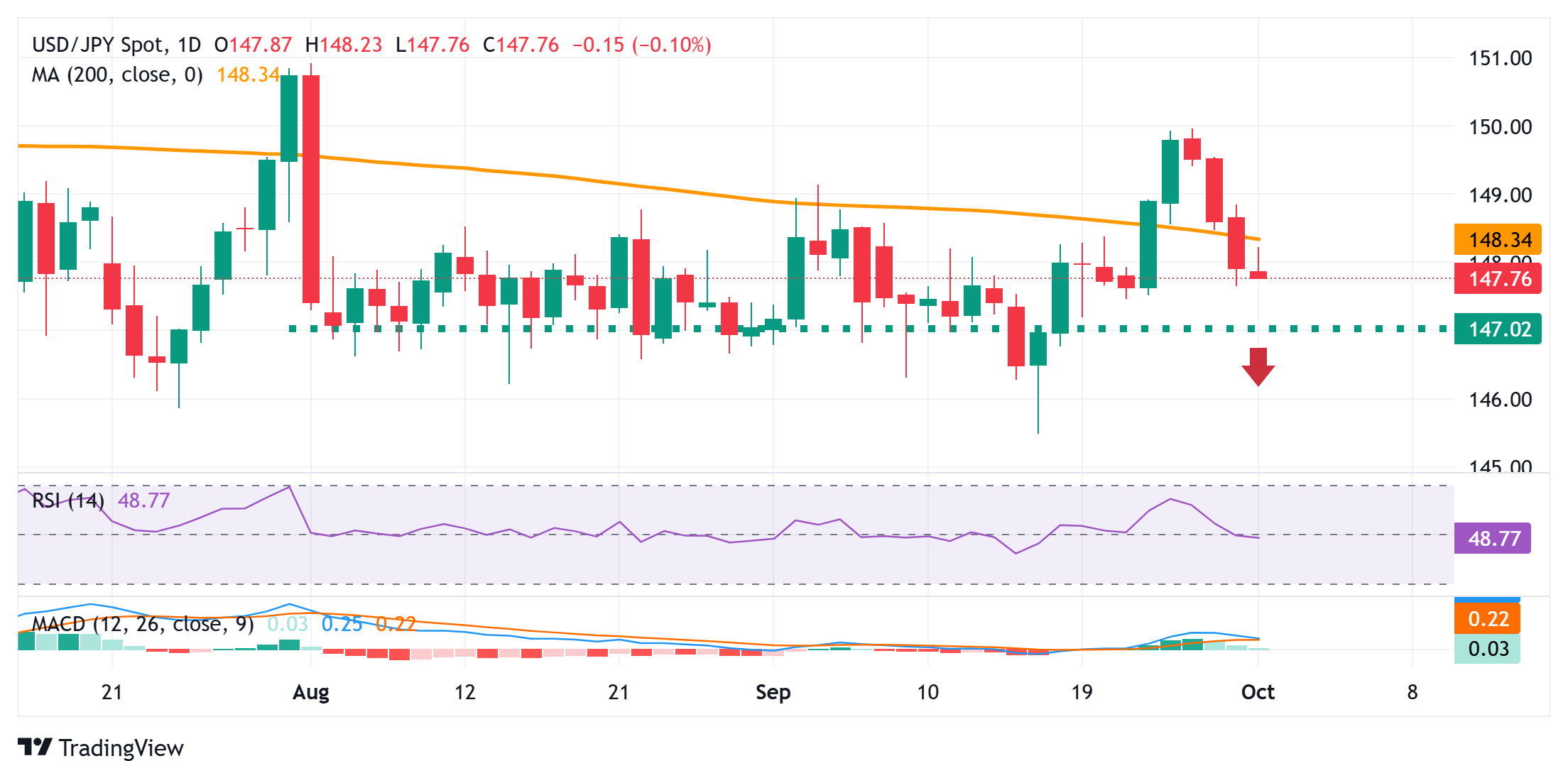Japanese Yen attracts some follow-through buying for the fourth straight day against a broadly weaker USD.Hawkish BoJ expectations and sustained safe-haven buying turn out to be key factors underpinning the JPY.Fed rate cut bets and the US government shutdown weigh on the USD and exert pressure on USD/JPY.
The Japanese Yen (JPY) turns positive for the fourth straight day against a broadly weaker US Dollar (USD) and rallies to a one-and-a-half-week low heading into the European session on Wednesday. The Summary of Opinions from the Bank of Japan’s (BoJ) September meeting, released on Tuesday, reaffirmed market bets that the central bank will stick to its policy normalization path. This, along with rising geopolitical tensions and the US government shutdown, is seen driving flows towards the safe-haven JPY.
Meanwhile, hawkish BoJ expectations mark a significant divergence in comparison to the growing market acceptance that the US Federal Reserve (Fed) will lower borrowing costs twice this year. The latter drags the USD to a one-week low, and the resultant narrowing US-Japan rate differential benefits the lower-yielding JPY. This, in turn, contributes to the USD/JPY pair’s slide below mid-147.00s and backs the case for an extension of the recent corrective fall from the highest level since August 1 set last week.
Japanese Yen bulls retain control amid hawkish BoJ and sustained safe-haven buyingJapan’s Manufacturing PMI for September was finalized at 48.5, down from 49.7 in the previous month and marking the fastest pace of contraction in six months. That said, the Bank of Japan’s Tankan survey signaled a slight improvement in business sentiment among large Japanese manufacturers for the second consecutive quarter. In fact, the Tankan Large Manufacturers’ Index increased from 13 to 14 during the July-September period.This comes on top of the BoJ Summary of Opinions from the September meeting released on Tuesday, indicating increasing pressure from hawks to normalise policy, and keeps the door open for an imminent rate hike. Traders are still pricing in the possibility of a 25-basis-point rate hike by the BoJ in October, which continues to act as a tailwind for the Japanese Yen and limits the downtick witnessed during the Asian session on Wednesday.Meanwhile, a Republican spending bill failed to pass through the Senate on Tuesday, leading to a partial US government shutdown starting midnight. A prolonged shutdown could have an adverse effect on economic performance and set the stage for a more aggressive policy easing by the US Federal Reserve. According to the CME Group’s FedWatch Tool, traders are pricing in a greater chance of two Fed rate cuts in October and December.On the economic data front, the US Bureau of Labor Statistics (BLS) reported in the Job Openings and Labor Turnover Survey (JOLTS) on Tuesday that the number of job openings on the last business day of August stood at 7.22 million. The reading was slightly above the 7.2 million estimated, though it does little to impress the US Dollar bulls or assist the USD/JPY pair to build on its modest intraday move up to the 148.20-148.25 region.Traders now look forward to Wednesday’s US economic docket – featuring the release of the ADP report on private-sector employment and the ISM Manufacturing PMI. The US Labor Department said Monday its statistics agency would halt data releases – including Friday’s closely-watched Nonfarm Payrolls (NFP) report – if a partial government shutdown occurs, leaving the USD at the mercy of comments from influential FOMC members.USD/JPY could stall the downfall near the 147.00 pivotal support
From a technical perspective, the USD/JPY pair’s intraday uptick on Wednesday falters ahead of the 200-day Simple Moving Average (SMA). Some follow-through selling below the overnight swing low, around the 147.65 region, could pave the way for deeper losses and drag spot prices to the 147.20-147.15 zone. This is followed by the 147.00 mark, which, if broken decisively, might shift the near-term bias in favor of bearish traders.
On the flip side, momentum back above the 200-day SMA, currently pegged around the 148.40 area, is likely to confront resistance near the 149.00 round figure. A sustained strength beyond the latter could allow the USD/JPY pair to surpass an intermediate barrier near the 149.40-149.45 region and make a fresh attempt to conquer the 150.00 psychological mark.
Fed FAQs
Monetary policy in the US is shaped by the Federal Reserve (Fed). The Fed has two mandates: to achieve price stability and foster full employment. Its primary tool to achieve these goals is by adjusting interest rates.
When prices are rising too quickly and inflation is above the Fed’s 2% target, it raises interest rates, increasing borrowing costs throughout the economy. This results in a stronger US Dollar (USD) as it makes the US a more attractive place for international investors to park their money.
When inflation falls below 2% or the Unemployment Rate is too high, the Fed may lower interest rates to encourage borrowing, which weighs on the Greenback.
The Federal Reserve (Fed) holds eight policy meetings a year, where the Federal Open Market Committee (FOMC) assesses economic conditions and makes monetary policy decisions.
The FOMC is attended by twelve Fed officials – the seven members of the Board of Governors, the president of the Federal Reserve Bank of New York, and four of the remaining eleven regional Reserve Bank presidents, who serve one-year terms on a rotating basis.
In extreme situations, the Federal Reserve may resort to a policy named Quantitative Easing (QE). QE is the process by which the Fed substantially increases the flow of credit in a stuck financial system.
It is a non-standard policy measure used during crises or when inflation is extremely low. It was the Fed’s weapon of choice during the Great Financial Crisis in 2008. It involves the Fed printing more Dollars and using them to buy high grade bonds from financial institutions. QE usually weakens the US Dollar.
Quantitative tightening (QT) is the reverse process of QE, whereby the Federal Reserve stops buying bonds from financial institutions and does not reinvest the principal from the bonds it holds maturing, to purchase new bonds. It is usually positive for the value of the US Dollar.


AloJapan.com